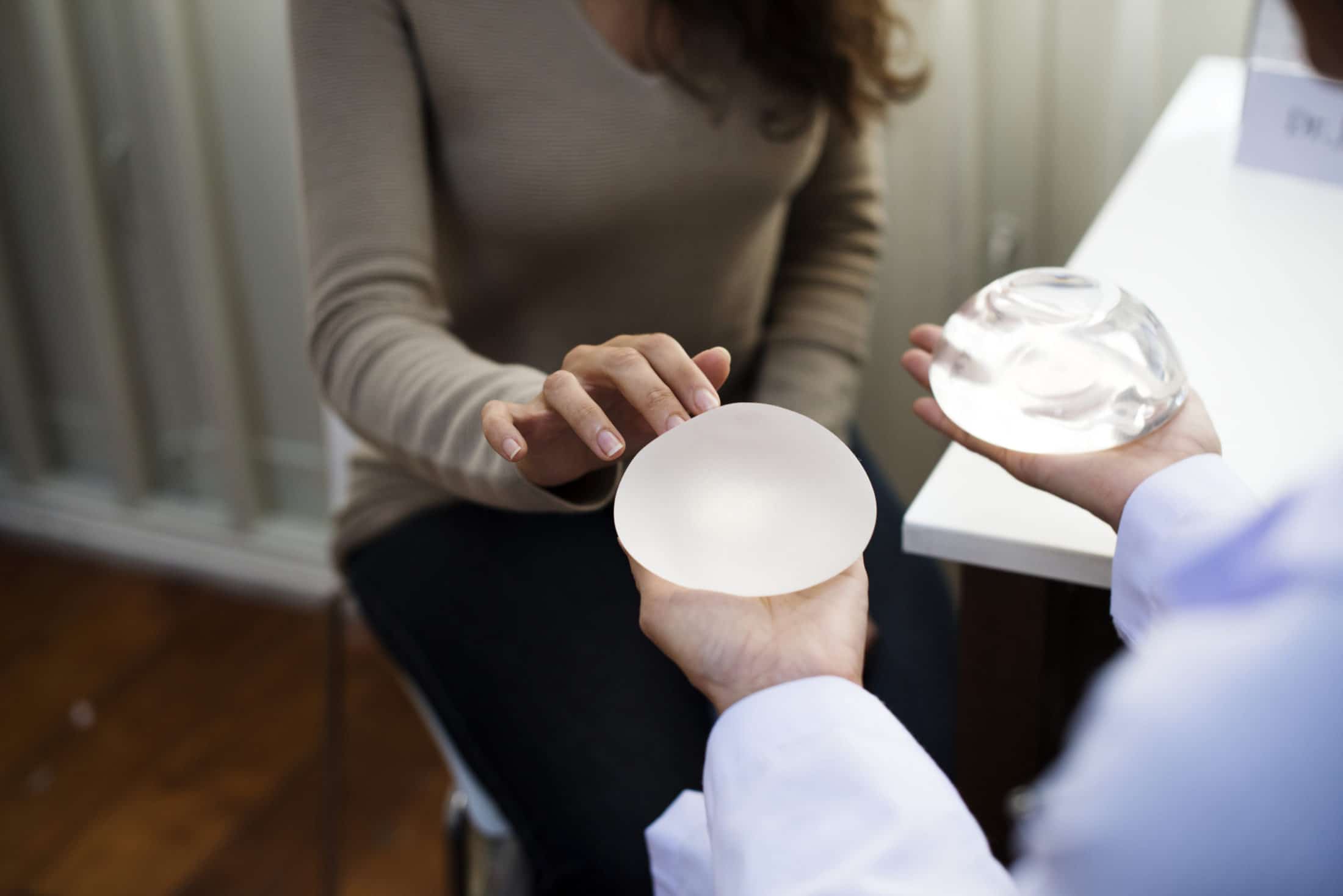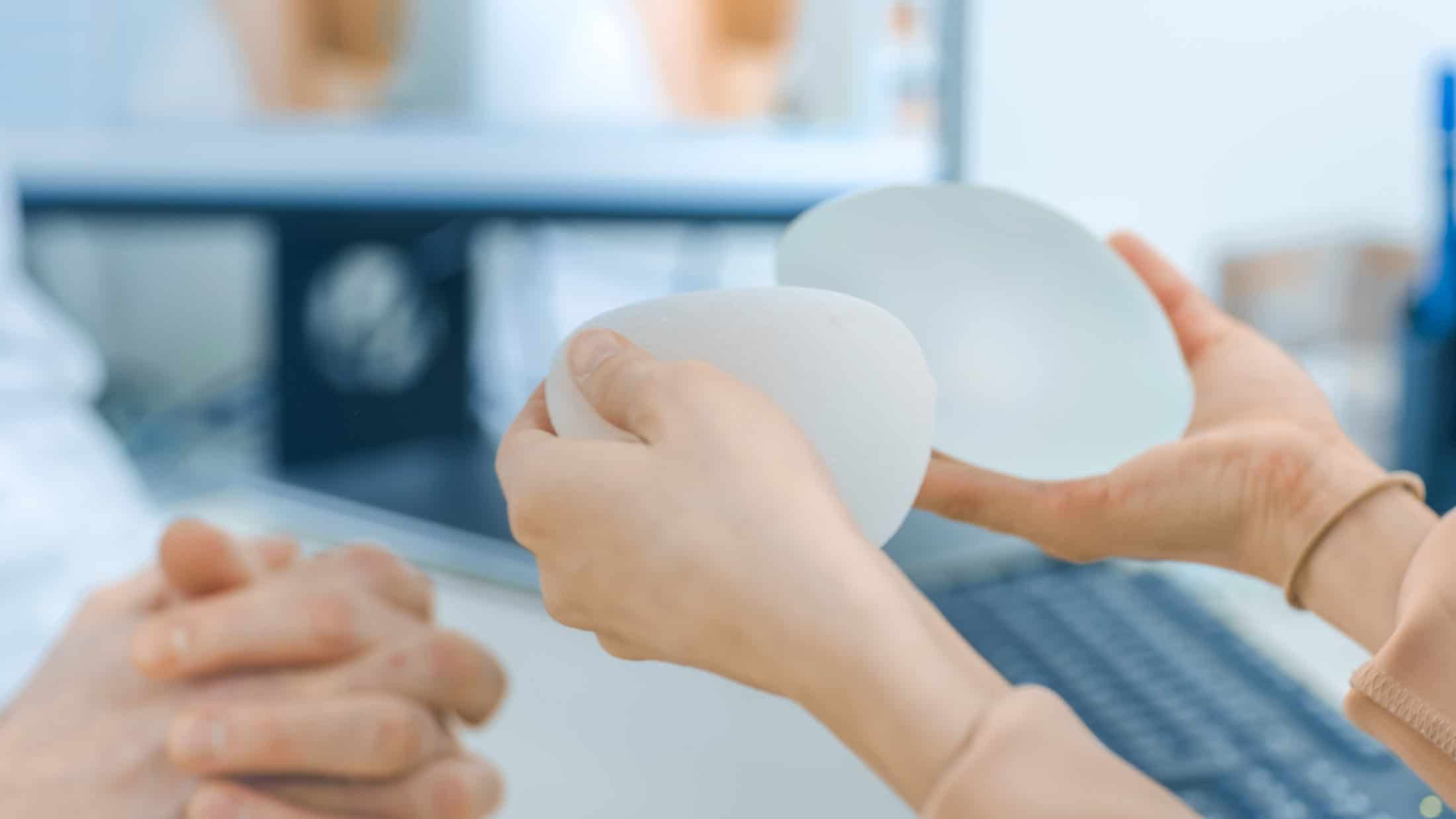What Are Breast Implants?
Breast implants have been used for many years to enhance the shape of the chest. The FDA-approved medical devices may be filled with saline, which is sterile salt water, or silicone. Saline implants provide uniformity of shape, feel, and firmness. If this type of implant were to rupture, breast size would decrease, alerting the patient of the problem. Silicone breast implants are often preferred due to their lifelike look and feel. The silicone gel that fills this device is thicker than saline, so it feels more like breast tissue. Silicone implants do require a slightly larger incision for placement. If this device were to rupture, the consistency of the gel would prevent the patient from knowing. For this reason, patients with silicone breast implants are advised to undergo periodic MRI imaging.
How Do I Pick A Breast Implant Size?
Breast implants vary in size, shape, and profile. Each of these variations affects appearance. The profile of a breast implant dictates how far forward the breast projects from the chest wall. Implant profile, more than actual size, involves the width of the implant base as well as its height, or forward projection. The projection vs. width affects characteristics such as side boob, profile appearance, and symmetry.
Who Is the Ideal Candidate For Breast Implants?
Many patients are good candidates for breast implants. Ideal patients are healthy individuals with an interest in enhancing the shape and size of their breasts. Reasons for breast augmentation should be personal and should not revolve around “fixing” something wrong with the body. When breast enhancement is conducted to make the body better, patients tend to be happier with their results.
What Should I Expect At A Breast Implant Consultation?
Breast augmentation consultations often involve trying on various breast implant sizes. This step enables patients to observe how different sizes and profiles may look in real life on their body frame, not from an image in a photo gallery. Plastic surgeons use years of training and experience to help patients discover which size, shape, and profile of implant would best suit their body type and lifestyle.
Who Should Not Get Breast Implants?
Certain health conditions may prevent patients interested in breast implants from becoming eligible for breast implant surgery. This procedure may not be suitable for patients who:
- Are pregnant, planning to become pregnant, or are currently breastfeeding
- Currently have breast cancer or an abnormal mammogram
- Have an active infection
- Unhealthy lifestyle habits such as excessive drug use or smoking
- Have unrealistic expectations for post-surgery results
What Should I Expect At a Breast Implant Consultation?
Breast augmentation consultations often involve trying on various breast implant sizes. This step enables patients to observe how different sizes and profiles may look in real life on their body frame, not from an image in a photo gallery. Plastic surgeons use years of training and experience to help patients discover which size, shape, and implant profile best suits their body type and lifestyle.
Types Of Breast Implants
Breast implants are silicone shells filled with either saline (saltwater) or silicone gel. Both implant types are very safe, and each offers its own advantages. Dr. Rhee will help you decide which kind is right for you and will discuss this with you during your consultation.

Saline Breast Implants
An advantage of saline breast implants is that, if ruptured, the saline (salt solution) is dissolved by the body naturally. A disadvantage of saline implants is that they may appear less natural in small-breasted or reconstructive patients. This is especially important for very thin women who have little breast tissue to cover the implant, or for women who have a breast injury or need breast reconstruction.
Silicone Breast Implants
Silicone gel-filled implants are the most popular choice of most of Dr. Rhee’s patients. Compared to saline implants, silicone implants are much softer and feel more natural. After many years, the U.S. Food and Drug Administration (FDA) has approved silicone breast implants for breast augmentation surgery.
What Our Patients Have To Say
Types Of Breast Implant Shapes
Of the two breast implant shapes, the round breast implant is the most common type used for breast augmentation. Many women choose round implants because they tend to provide the greatest amount of lift, fullness, and cleavage. Some women, however, feel that the results produced with round implants appear artificial, so they seek out more natural-looking alternatives.
Round Breast Implants
A round breast implant can have a smooth or textured surface. Due to a round implant’s symmetrical shape, it does not pose the risk of implant rotation. Round implants come in three different variations of shape: low, medium, and high profile. A higher profile can enhance the forward projection of the breasts, which would otherwise require larger breast implants with wider bases.
Teardrop Breast Implants
As the name indicates, a teardrop breast implant, also known as a contoured breast implant, is shaped like a teardrop. Breasts attain a more gently sloping contour with teardrop breast implants. Although the upper portion of breasts that have teardrop implants are not as full as breasts that have round implants, teardrop-shaped implants often provide greater projection by volume. For women who want more naturally shaped teardrop breasts, these implants may be the ideal choice. A teardrop implant requires a textured surface to prevent rotation because breasts can become distorted if the implant rotates. This is not a concern with round breast implants.
Benefits Of Teardrop Implants
Teardrop-shaped breast implants are a popular alternative to round implant devices. The teardrop shape has more fullness at the bottom with a gentle slope at the upper pole of the breast. This is also referred to as an anatomically-shaped implant. Even with the slope at the upper pole, teardrop implants typically provide greater projection from the chest wall. Due to their anatomical shape, teardrop breast implants must be textured to prevent them from shifting in the breast pocket.
Which Breast Implant Shape Is Right For You?
When choosing breast implants, the shape is an important consideration. The two basic breast implant shapes are round and teardrop. Breasts differ greatly from woman to woman, so the ideal breast implant shape for each patient must be determined with care.

Are There Any Risks with Breast Implant Surgery?
Although breast implants are FDA-approved and the procedure is safe, just like any other surgery, there are several risks that patients need to be aware of. These risks may include:
- Breast pain
- Rupture of the implant
- Infection
- Movement of the implant within the breast
- Scarring
- Brain fog
- Asymmetry
- Bleeding
- Hematoma
- Muscle pain
- Changes in skin or nipple sensation
Under Dr. Rhee’s care, patients can expect a high-quality procedure that minimizes these risks. By following her aftercare guidelines, patients can ensure a successful, complication-free recovery that easily manages common side effects and avoids risks from breast implant surgery.
Preparing For Your Breast Implant Surgery
Most patients need to do very little to prepare for their breast augmentation procedure. During our thorough consultation and examination, we do our best to identify pre-existing health conditions, medications, and lifestyle habits that may present challenges to recovery. Patients may be advised to modify certain medications or supplements that thin the blood. Otherwise, preparation revolves around planning for a smooth recovery.
Before breast augmentation surgery, it is helpful to:
- Arrange time off from work and social obligations
- Arrange reliable childcare and pet care if needed
- Make meals ahead of time that can be defrosted and heated
- Purchase post-operative supplies such as a digital thermometer and ice packs
- Have post-operative prescriptions filled
Recovery From Breast Implant Surgery
Recovery from breast implant surgery is generally easy for most patients. Comfort improves significantly within a matter of a few days. Patients should expect:
- Moderate discomfort in the first 24 to 48 hours after surgery. Prescription pain medication can alleviate this.
- Swelling and bruising may occur.
- Some patients experience slight nausea.
- Arm movements are restricted for 24 to 48 hours, which prevents driving and hair washing.
- Nicotine, alcohol and any supplements or medications that thin the blood should be avoided for the first few days after surgery.
- A few days after surgery, displacement exercises may begin. This may include breast massage.
- Driving may resume as soon as 48 hours after surgery as long as prescription pain medication is not being consumed.
- A follow-up appointment will be scheduled for one to two weeks after surgery.
- Light activities may resume one to two weeks after surgery.
- Heavy lifting and strenuous exercise can resume when cleared by the surgeon. This may take 6 to 12 weeks.
- Breasts begin to settle into their position by one month after surgery.
- Four to six weeks after surgery, regular bras may be worn.
Can I Get My Implants Removed?
Breast implants can be removed if a patient wishes. Sometimes, implants are removed to correct post-surgical complications such as capsular contracture. In some cases, patients choose to have smaller implants replaced with larger devices. In others, patients undergo breast implant removal with a breast lift, choosing to improve the shape of natural breast tissue rather than replace implants.
How Do I Know When I Need to Remove My Implants?
Your implants may need to be removed in the case of an emergency, such as an implant rupture, infection, or other type of implant complication. These complications may include:
- Hardening of scar tissue around the implants
- Implant rupture, leakage, and deflation
- Hard knots
- Noticeable unevenness of the breasts
- Swelling
- Numbness
- Burning
- Rippling appearance in the breast tissue
- Changes in implant position
How Long Will My Breast Implants Last?
With the proper care, breast implants can last anywhere from 10 to 20 years, depending on the type of breast implants you have. After 10 to 15 years, it is recommended to get your implants checked and replaced to maintain your desired appearance and ensure your implants and health are in good condition.
Schedule A Complimentary Consultation
To learn more about breast implants, contact Charlotte Ann Rhee MD by calling (631) 424-6707 today! We offer free consultations at our office in Huntington, NY serving all of Long Island.
